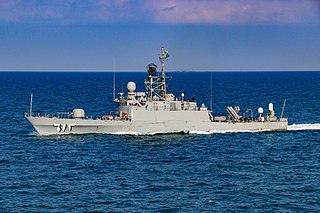
The 46 Knox-class frigates were the largest, last, and most numerous of the US Navy's second-generation anti-submarine warfare (ASW) escorts. Originally laid down as ocean escorts, they were all redesignated as frigates on 30 June 1975, in the 1975 ship reclassification plan and their hull designation changed from 'DE' to 'FF'. The Knox class was the Navy's last destroyer-type design with a steam turbine powerplant.

HNLMS Jan van Brakel (F825) was a frigate of the Kortenaer class in service with the Royal Netherlands Navy from 1983 to 2001. She was renamed HS Kanaris (F464) on transfer to the Hellenic Navy in 2002.

The Tre Kronor class was a class of two cruisers built for the Swedish Navy during World War II, comprising Tre Kronor and Göta Lejon. Tre Kronor was discarded in 1968 and Göta Lejon was sold to Chile in 1971. Renamed Almirante Latorre, she remained in service until being discarded in 1986.

The Kortenaer class was a class of anti-submarine frigates of the Royal Netherlands Navy. Like other frigate types of the 1970s and 1980s, they featured a COGOG propulsion system with separate cruise and sprint gas turbines. Ten were built by De Schelde in Vlissingen and two by Wilton-Fijenoord in Schiedam between 1978 and 1982. Only ten served with the Royal Netherlands Navy: two were sold to Greece's Navy while still under construction and replaced by two Jacob van Heemskerck-class frigates which were an air defence variant of the Kortenaer class. The Greek frigates were renamed the Elli class. After service with the Dutch ended, eight of the frigates were sold to Greece in 1992 and the remaining two to the United Arab Emirates. Three of the ships have since been retired from active military service with one converted into the superyacht Yas.

The Jacob van Heemskerck-class frigate was a class of frigates of the Royal Netherlands Navy. They were designed to be an air defence version of the Kortenaer class. The helicopter was replaced by a Standard medium range surface-to-air missile (SAM) system and associated radars. Two ships were built for the Royal Netherlands Navy. In 2005 they were sold to the Chilean Navy.

The Badr class is a class of corvette built by the United States and operated by the Saudi Navy. The class has been relegated to a coastal defence role following the modernisation of the Saudi fleet. There are four vessels in service; Badr, Al Yarmook, Hitteen and Tabuk.

Tapi-class corvettes are a class of two corvettes that were built for the Royal Thai Navy in the early 1970s.

HNLMS Van Kinsbergen (F809) was a frigate of the Kortenaer class. The ship was in service with the Royal Netherlands Navy from 1980 to 1995. The frigate was named after Dutch naval hero Jan Hendrik van Kinsbergen.

HNLMS Overijssel (D815) was a destroyer of the Friesland class. The ship was in service with the Royal Netherlands Navy from 1957 to 1982. The destroyer was named after the Dutch province of Overijssel and was the twelfth ship with this name. In 1982 the ship was taken out of service and sold to Peru where it was renamed Coronel Bolognesi.

HNLMS Callenburgh (F808) was a frigate of the Kortenaer class. The ship was in service with the Royal Netherlands Navy from 1979 to 1994. The frigate was named after Dutch naval hero Gerard Callenburgh. The ship's radio call sign was "PADB".

HNLMS Van Speijk (F802) was a frigate of the Van Speijk class. The ship was in service with the Royal Netherlands Navy from 1967 to 1986. The ship's radio call sign was "PAVA". She was sold to the Indonesian Navy where the ship was renamed KRI Slamet Riyadi (352). The ship was decommissioned in 2019.

HNLMS Pieter Florisz (F826) was a frigate of the Kortenaer class. The ship was in service with the Royal Netherlands Navy from 1983 to 2001. The frigate was named after Dutch naval hero Pieter Floriszoon. The ship's radio call sign was "PADI".

KRI Oswald Siahaan (354) is an Ahmad Yani-class frigate operated by the Indonesian Navy. Prior to her service in the Indonesian Navy, she served in the Royal Netherlands Navy as Van Speijk-class frigateHNLMS Van Nes (F805).

HNLMS Van Galen (F803) was a frigate of the Van Speijk class. The ship was in service with the Royal Netherlands Navy from 1967 to 1987. The ship's radio call sign was "PAVB". She was sold to the Indonesian Navy where the ship was renamed KRI Yos Sudarso (353).

HNLMS Evertsen (F815) was a frigate of the Van Speijk class. The ship was in service with the Royal Netherlands Navy from 1967 to 1989. The ship's radio call sign was "PAVG". She was sold to the Indonesian Navy where the ship was renamed KRI Abdul Halim Perdanakusuma (355).

HNLMS Isaac Sweers (F814) is a frigate of the Van Speijk class. The ship was in service with the Royal Netherlands Navy from 1968 to 1990. The ship's radio call sign was "PAVF". She was sold to the Indonesian Navy where the ship was renamed KRI Karel Satsuitubun (356).

HNLMS Tjerk Hiddes (F804) was a frigate of the Van Speijk class. The ship was in service with the Royal Netherlands Navy from 1967 to 1986. The ship's radio call sign was "PAVC". She was sold to the Indonesian Navy where the ship was renamed KRI Ahmad Yani (351).

The Centauro class consisted of four frigates built for the Italian Navy during the 1950s. They entered service in 1957, with the last one being stricken in 1985.

Castore was one of four Centauro-class frigates built for the Italian Navy in the 1950s.

Cigno was one of four Centauro-class frigates built for the Italian Navy in the 1950s.




















